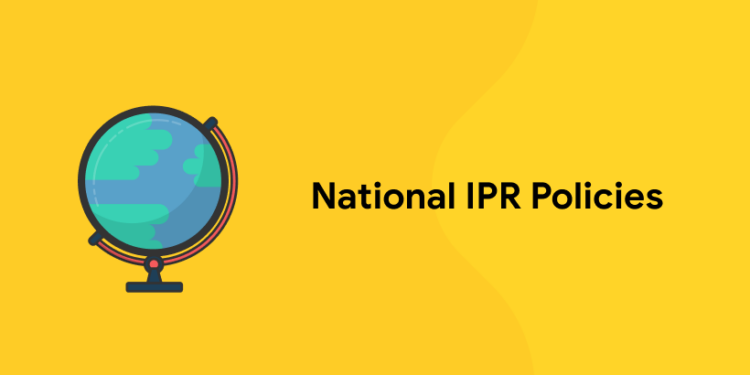Table of Contents
Hope you have heard about the name Macbook. Basically, it is a laptop of the company called Apple. But if you start to notice, no company in the world sells their products in the name of Macbook. They don’t even call the Microsoft laptop as the Macbook of Microsoft. If you notice, no phone company in the world manufactures and adapts IOS to their phones. It is just because Macbook is a trade mark registered under the trade mark law and IOS is an intellectual property registered under Intellectual property right act which falls under the intellectual property right regime. Do you know how the IPR Laws are evolved and how the legal framework and policies regarding the same are worked? Through this blog let us check out the National IPR policies.
Register in to get the latest Exam Study Materials, PDFs, Video Lessons, Mock Tests! Limited Offer!
IPR Laws in India – History and Overview
The IPR or rather the abbreviated form of intellectual property rights has been evolved through a long process of time. Several national conventions have been conducted for the promotion of each and every country to formulate a global IPR policy and legal framework for the protection of the same. Even though there were so many conventions held in different countries, the TRIPS agreement proposed by the World Trade Organization is the most widely accepted and most members signed intellectual property agreement in the world. TRIPS is the abbreviated form of the Trade Related Aspects of the Intellectual Property Right. The TRIPS Agreement forced the member countries to adopt the policy and provisions contained in the agreement to their domestic laws regarding the IPR Laws.
The significance of the TRIPS agreement can be summed up as below:
- There was a global uniformity for the policies associated with the IPR
- Pushed forward for the globally accepted legal framework of IPR laws
- Identified different subsets in the Intellectual Properties
- Accepted the foreign intellectual properties
- Regulated the international trade relating to the intellectual property rights
The laws got amended and enacted based on the TRIPS agreement can be summed up as below in the Indian context:
- The Intellectual Property Act 1999
- The Trade Mark Act 1999
- The Copyright Act 1957
- Geographical Indications of Goods (Registration and Protection) Act, 1999
- Semiconductor Integrated Circuits Layout Design Act 2000
The National Policy on IPR
1: Who was the first woman President of India?
The Union Cabinet approved the National Intellectual Property Rights (IPR) Policy on 12th May, 2016 that shall lay the future roadmap for IPRs in India. The Policy recognises the abundance of creative and innovative energies that flow in India, and the need to tap into and channelize these energies towards a better and brighter future for all. The National IPR Policy is a vision document that encompasses and brings to a single platform all IPRs. It views IPRs holistically, taking into account all inter-linkages and thus aims to create and exploit synergies between all forms of intellectual property (IP), concerned statutes and agencies. It sets in place an institutional mechanism for implementation, monitoring and review. It aims to incorporate and adapt global best practices to the Indian scenario.
Register in to get the latest Exam Study Materials, PDFs, Video Lessons, Mock Tests! Limited Offer!
Free UPSKILLING Courses!
Take your first step toward mastering in-demand skills, acing interviews, and securing top-tier jobs with Entri's free upskilling courses.
Start Learning!Objectives of the National IPR Policy
The National IPR policy is built upon the seven objectives to achieve the mission of stimulating a dynamic, vibrant and balanced intellectual property rights system in India. The seven Objectives are as follows.
| No | Objective | Significance |
| Objective 1 | IPR Awareness: Outreach and Promotion | To create public awareness about the economic, social
and cultural benefits of IPRs among all sections of society |
| Objective 2 | Generation of IPR | To stimulate the generation of IPRs |
| Objective 3 | Legal and Legislative Framework – | To have strong
and effective IPR laws, which balance the interests of rights owners with larger public interest |
| Objective 4 | Administration and Management | To modernize and strengthen service oriented IPR administration |
| Objective 5 | Commercialization of IPR | Get value for IPRs through commercialization |
| Objective 6 | Enforcement and Adjudication – | To strengthen the enforcement and adjudicatory mechanisms for combating IPR infringements |
| Objective 7 | Human Capital Development | To strengthen and expand human resources, institutions and capacities for teaching, training, research and skill building in IPRs |
Conclusion
The IPR is the future and highly growing sector in the manufacturing, research and development and legal sectors. Patent registration and IPR related legal works and litigation methods are very much being developed in the modern period. Apart from the legislative framework of enactments, the executive policies also strengthen the effective enforcement of Intellectual Property Rights and safeguard them. Study the National Policy of IPR and its objectives and make your seat confirm by excelling in general awareness in competitive examinations. Keep studying, keep winning!












